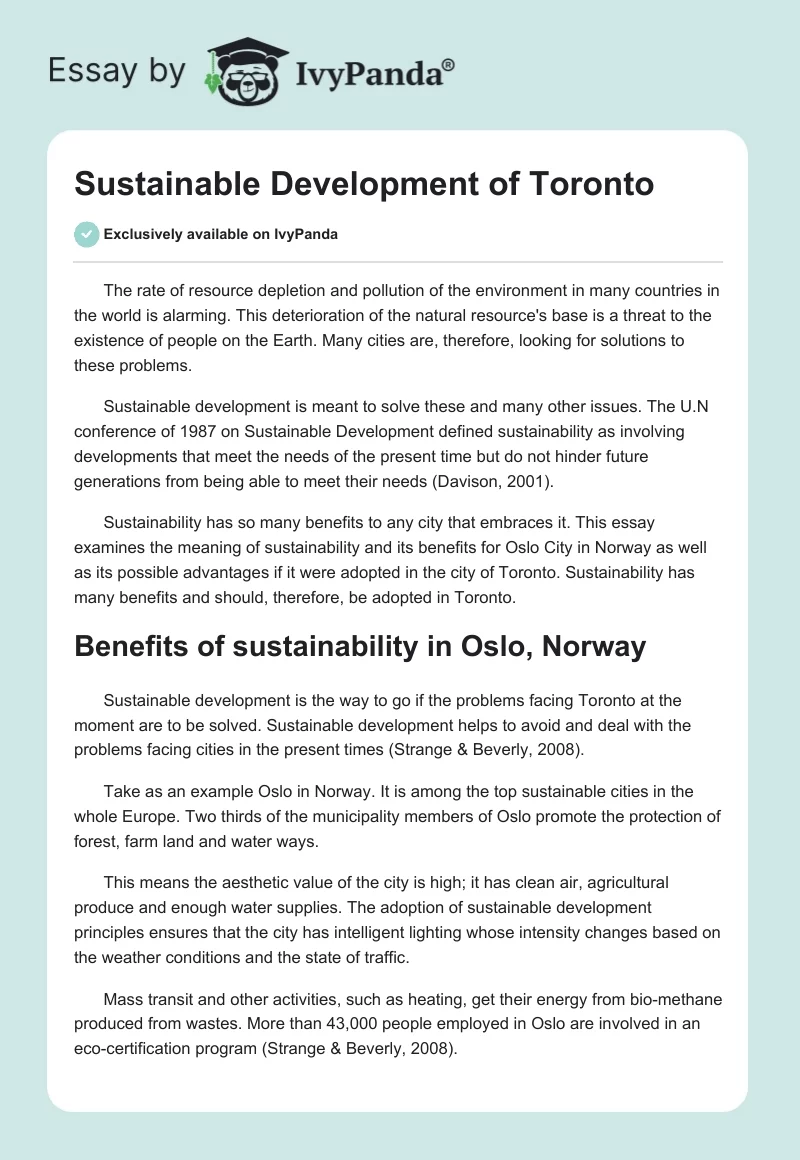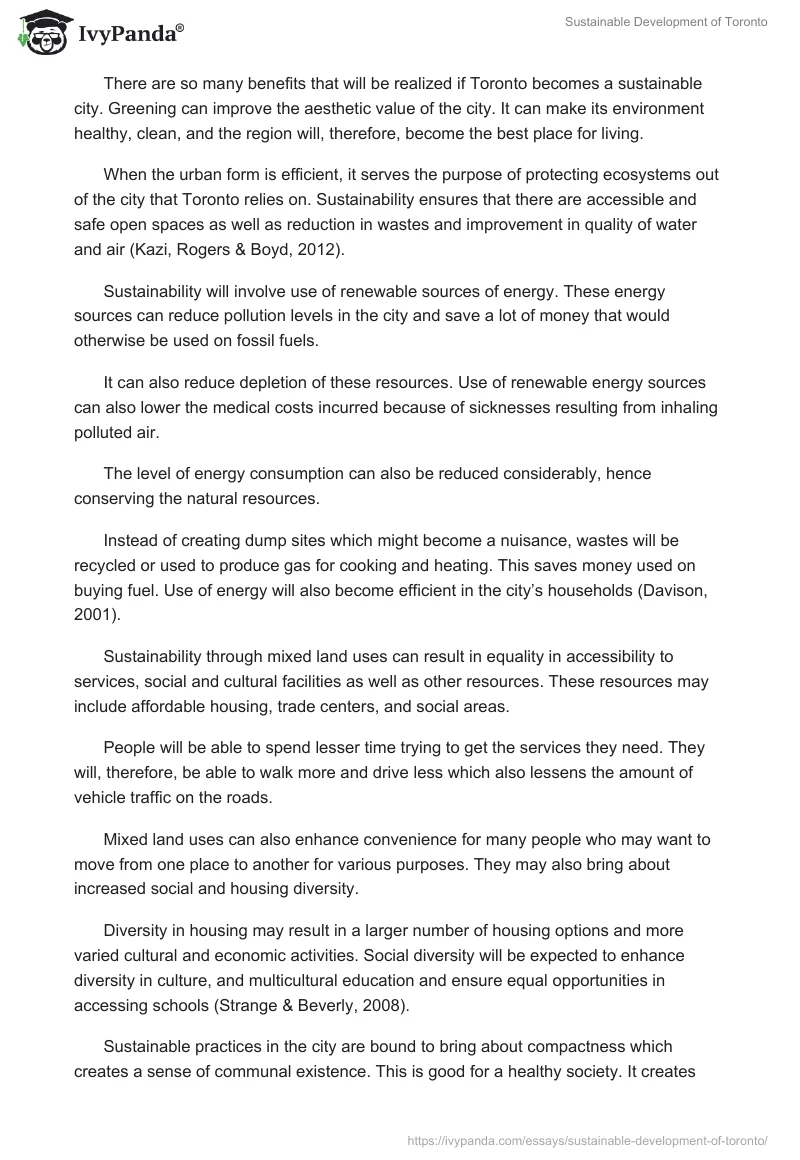The rate of resource depletion and pollution of the environment in many countries in the world is alarming. This deterioration of the natural resource’s base is a threat to the existence of people on the Earth. Many cities are, therefore, looking for solutions to these problems.
Sustainable development is meant to solve these and many other issues. The U.N conference of 1987 on Sustainable Development defined sustainability as involving developments that meet the needs of the present time but do not hinder future generations from being able to meet their needs (Davison, 2001).
Sustainability has so many benefits to any city that embraces it. This essay examines the meaning of sustainability and its benefits for Oslo City in Norway as well as its possible advantages if it were adopted in the city of Toronto. Sustainability has many benefits and should, therefore, be adopted in Toronto.
Benefits of sustainability in Oslo, Norway
Sustainable development is the way to go if the problems facing Toronto at the moment are to be solved. Sustainable development helps to avoid and deal with the problems facing cities in the present times (Strange & Beverly, 2008).
Take as an example Oslo in Norway. It is among the top sustainable cities in the whole Europe. Two thirds of the municipality members of Oslo promote the protection of forest, farm land and water ways.
This means the aesthetic value of the city is high; it has clean air, agricultural produce and enough water supplies. The adoption of sustainable development principles ensures that the city has intelligent lighting whose intensity changes based on the weather conditions and the state of traffic.
Mass transit and other activities, such as heating, get their energy from bio-methane produced from wastes. More than 43,000 people employed in Oslo are involved in an eco-certification program (Strange & Beverly, 2008).
There are so many benefits that will be realized if Toronto becomes a sustainable city. Greening can improve the aesthetic value of the city. It can make its environment healthy, clean, and the region will, therefore, become the best place for living.
When the urban form is efficient, it serves the purpose of protecting ecosystems out of the city that Toronto relies on. Sustainability ensures that there are accessible and safe open spaces as well as reduction in wastes and improvement in quality of water and air (Kazi, Rogers & Boyd, 2012).
Sustainability will involve use of renewable sources of energy. These energy sources can reduce pollution levels in the city and save a lot of money that would otherwise be used on fossil fuels.
It can also reduce depletion of these resources. Use of renewable energy sources can also lower the medical costs incurred because of sicknesses resulting from inhaling polluted air.
The level of energy consumption can also be reduced considerably, hence conserving the natural resources.
Instead of creating dump sites which might become a nuisance, wastes will be recycled or used to produce gas for cooking and heating. This saves money used on buying fuel. Use of energy will also become efficient in the city’s households (Davison, 2001).
Sustainability through mixed land uses can result in equality in accessibility to services, social and cultural facilities as well as other resources. These resources may include affordable housing, trade centers, and social areas.
People will be able to spend lesser time trying to get the services they need. They will, therefore, be able to walk more and drive less which also lessens the amount of vehicle traffic on the roads.
Mixed land uses can also enhance convenience for many people who may want to move from one place to another for various purposes. They may also bring about increased social and housing diversity.
Diversity in housing may result in a larger number of housing options and more varied cultural and economic activities. Social diversity will be expected to enhance diversity in culture, and multicultural education and ensure equal opportunities in accessing schools (Strange & Beverly, 2008).
Sustainable practices in the city are bound to bring about compactness which creates a sense of communal existence. This is good for a healthy society. It creates strong community bonds which help them cooperate in solving problems associated with security and crime (Schmandt & Herbert, 2000).
Many people resist sustainable development because it may cause less short term economic benefits, need for land reforms, that are not politically popular, conflict management, education, compromise, infrastructural development and a lot of training and research among others.
However, these issues can be easily managed because every good thing must cost something. Besides, the costs are very small compared to the long term benefits of sustainability (Blewitt, 2012).
In conclusion, Toronto should adopt sustainability as a way of development because of its advantages in this essay.
If this happens, there is an assurance that sustainability will improve the image of the city, prevent depletion of resources via use of renewable energy sources, reduce pollution of air, increase accessibility to services, increase diversity in the city and create a sense of communal living.
References
Blewitt, J. (2012). Understanding Sustainable Development. London, UK: Routledge.
Davison, A. (2001). Technology and the Contested Meaning of Sustainability. New York, USA: SUNY Press.
Kazi J., Peter, R. & John, B. (2012). An introduction to Sustainable Development. London, UK: Routledge.
Schmandt, J., & Calvin, H. (2000). The Challenge of Transition. Cambridge, UK: Cambridge University Press.
Strange, T., & Anne, B. (2008). Sustainable Development: Linking Economy, Society, Environment. Paris, France: OECD.


